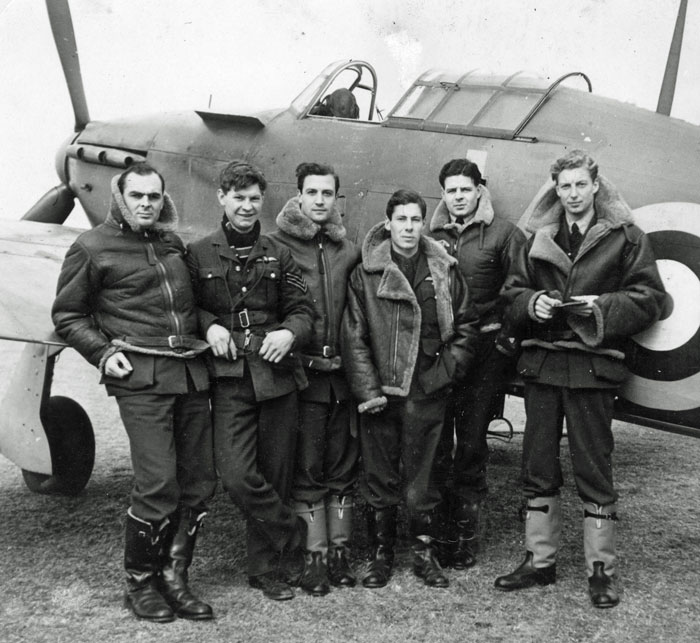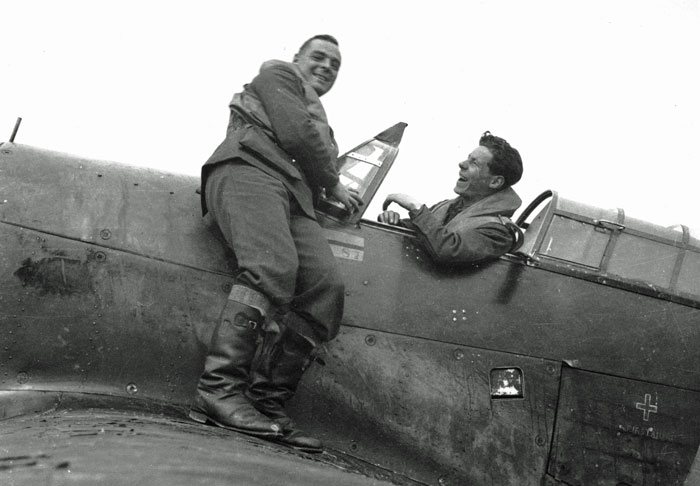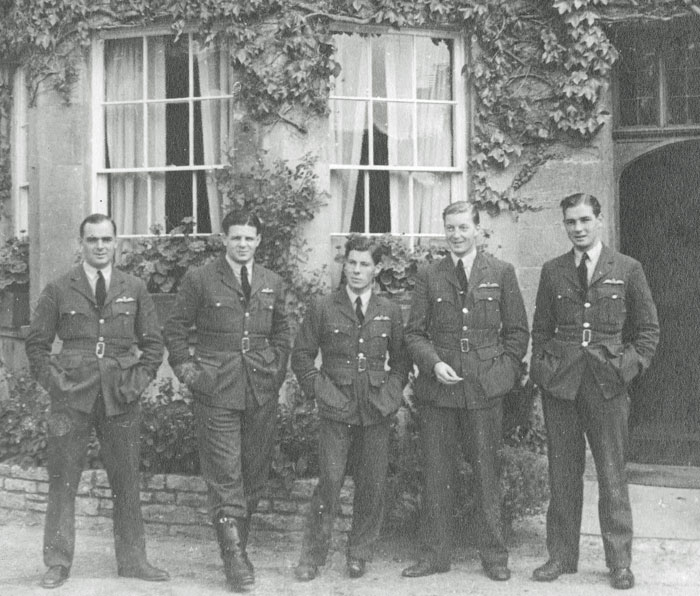The Airmen's Stories - F/O R Watson
Rafael Watson was born on the 16th November 1912 in Buenos Aires, Argentina, the youngest of four children of an English farmer and cattle importer.
Educated at Dunstable Grammar School, he showed an early aptitude for engineering. He joined the RAF on a short service commission in 1937, and began his initial training on 6th December 1937 at the RAF Civil Training College at Desford, Leicester by Reid & Sigrist Ltd.
He then moved to 7 Elementary & Reserve Flying Training School, Desford and qualified in February 1938 rated as 'Above average'.
He was posted to 5 FTS Sealand on 5th March 1938 where he trained as a fighter pilot on Hawker Hart, Audax and Fury aircraft, graduating on 15th September 1938.

Above L to R: F/O R Watson, Sgt. LA Thorogood, P/O RFF Malengrau (BEL), F/lt. IR Gleed, F/O KW Tait (NZ), F/O RMS Rayner.
On 17th September 1938 he was posted to 87 (F) Squadron at Debden, flying Hurricanes. Upon the outbreak of war, he moved with the squadron to France as part of 60 Wing, the Air Component of the British Expeditionary Force (BEF), flying patrols with ‘A’ Flight in the Lille-Seclin sector.
On 17th May 1940 he probably destroyed a Me110 and on the 18th he destroyed another.
On 20th May he force landed in Hurricane P2819 after ground strafing German troops on the Arras-Douai road. Later that day he flew back to North Weald with S/Ldr Dewar, F/Lt Gleed and F/Lt Rayner. The squadron had lost fifty percent of its strength and between 22nd May and 8th June it refitted at Church Fenton.
Watson served with 87 Squadron throughout the Battle of Britain. On 8th June 1940 they moved to Exeter to provide fighter cover for the front from Portsmouth to Plymouth during June to November, with some night patrols from Charmy Down and Bibury.

Flying Exeter to Bibury September 1940
Above L to R: F/lt. IR Gleed, P/O FXE de Spirlet (BEL), P/O HT Mitchell (CAN), Sgt. FV Howell, photo taken from Watson's aircraft.
During October 1940 to May 1941, 87 Squadron became a Night Fighter unit and Watson was flying night sorties. But on 19th May he was detached with ‘A’ Flight to St.Mary’s in the Scilly Islands for “Operation Fishing” – the interception of enemy mine-laying and maritime recce flights in the Western Approaches. With “Widge” Gleed,(then 87’s CO), they intercepted a Ju88 on 28th May, but it escaped.
He was promoted to Flight Lieutenant on 3rd September 1941 (by then he was the longest serving pilot in 87 Squadron), and in December 1941 he went to the Special Duties List, reporting to the Gloster Aircraft Company as a test pilot.

F/O R Watson, F/lt. IR Gleed (in cockpit) at St Marys, Scillies 1940.
He stayed here until August 1942, undertaking development flying on the problematic Typhoon. Then in September 1942 he was posted to 3501 Servicing Unit at Cranfield, where he flew Service Trials for the Tempest. He moved with 3501 to Middle Wallop and then Odiham. On 1st January 1944 he was promoted Squadron Leader and in June 1944 he was made OC Test Flying.

Above L to R: F/O R Watson, F/O KW Tait (NZ), F/lt. IR Gleed, F/O RMS Rayner, P/O PW Comely at White Swan Inn, Bibury 1940.
In March 1945 Watson was seconded to D. Napier & Son, Ltd. for development testing of the Sabre engine in the Hawker Typhoon and Tempest aircraft. During a Typhoon test flight in May 1945 the engine of his aircraft blew up at altitude and he was obliged to bale out, saved by his parachute he thus qualified for membership of the Caterpillar Club.
He was released from the RAF in 1947 and, having invested heavily in the post-war East Africa Groundnut Scheme, he emigrated to Tanganyika. Despite the failure of the scheme, he stayed on in Tanganyika as a tobacco farmer. But following independence in 1962 his farm was compulsorily purchased, and he moved to North Queensland in Australia, where he worked as a mechanic.
He returned to England with the Australian and New Zealand contingents for the 25th Anniversary of the Battle of Britain in 1965, and returned permanently in 1966. He returned to education, taking a diploma in electronics and subsequently developing a career in engineering, specialising in non-destructive testing, which included working with Rolls Royce Aeroengines Ltd.
He lived in Bletchley and died in Milton Keynes on 18th February 1986.
He had experience of flying over 40 different types of aircraft in the RAF.
Majority of research courtesy of Thomas Watson (son).
Images courtesy of the collection of F/O R Watson.
|